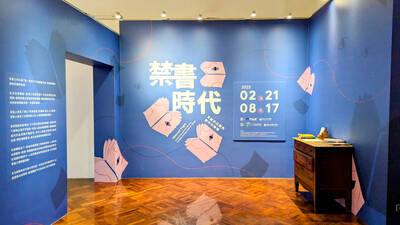Mass shootings, artificial intelligence and genetically modified foods are topics not often associated with theater.
But audiences in Canada’s Quebec province are flocking to documentary plays that seek to take on difficult topics and spur debate.
“Bringing reality to a stage is challenging,” especially when “tackling complex subjects,” says Marie-Joanne Boucher, an actress who co-produced a play about the 1989 Ecole Polytechnique massacre, an anti-feminist university mass shooting that left 14 people dead and deeply scarred the nation.

Photo: AFP
In the play, Project Polytechnique, two main actors recount the horrors of the attack and press the audience to consider what can be done to prevent more mass shootings.
The words of one of the survivors and of a police officer who was among the first to arrive at the grisly scene are recited, along with comments from a firearms enthusiast and anti-feminists who continue years later in online forums to justify the attack and adulate the killer.
“We say to the spectator: Come to the theater and you will be entertained, but you will also leave with a better overview of today’s society,” says Annabel Soutar, co-founder of Porte Parole, a pioneer of the genre in Quebec.
Over the past two decades, her theater company has produced about 20 plays on themes as diverse as hydroelectricity, genetically modified foods and health care. Since then, many other docu-theater companies have followed suit.
ONE IN FOUR PLAYS
Debuting in the 1920s, in Germany and then in Russia, documentary theater initially developed to support communist ideology. It then spread during the 20th century throughout the world and moved away from propaganda to focus on social topics.
In Canada, it was more in the English-speaking part of the country that the genre was embraced in the 1970s, but it has now taken on new life in Quebec.
Approximately one in four theater productions in Quebec today is a docu-play, according to Herve Guay, an academic who edited a book on the genre.
Part of the reason for this runaway success is the broad “aesthetic variety” of docu-plays, says Guay.
Montreal resident Emilie Cabouat-Peyrache recently saw Project Polytechnique and loved it.
“Documentary theater allows you to explore a lot of subjects, sometimes surprising ones,” she said.
’APOTHEOSIS OF DOCUMENTARY THEATER’
Another popular docu-play, Run de lait (Milk Run), deals with the disappearance of small Quebec farms, Canada’s milk quota system and the mental health of farmers.
“We are at the apotheosis of documentary theater and Quebec society is ripe to be challenged in this way on social issues,” says Justin Laramee, who produced the show. He added that he was pleased to perform it for both urban dwellers and farmers alike.
“It started conversations, and we need that in our society now.”
Allowing audiences to explore new worlds were key objectives for the creators of Pas perdus, a documentary play about identity, heritage and memory featuring non-actors performing tasks silently while a recording of their voices plays over speakers.
“We live in a society with a lot of noise, a lot of positions taken, not necessarily a lot of depth, and I think we need a return to authenticity,” explains the play’s co-writer Anais Barbeau-Lavalette
The play has elicited strong responses from audiences.
“We get a lot of feedback,” Emile Proulx-Cloutier, who wrote the play with Barbeau-Lavalette. “Spectators often tell me that they leave shaken.”

There is a Chinese Communist Party (CCP) plot to put millions at the mercy of the CCP using just released AI technology. This isn’t being overly dramatic. The speed at which AI is improving is exponential as AI improves itself, and we are unprepared for this because we have never experienced anything like this before. For example, a few months ago music videos made on home computers began appearing with AI-generated people and scenes in them that were pretty impressive, but the people would sprout extra arms and fingers, food would inexplicably fly off plates into mouths and text on

On the final approach to Lanshan Workstation (嵐山工作站), logging trains crossed one last gully over a dramatic double bridge, taking the left line to enter the locomotive shed or the right line to continue straight through, heading deeper into the Central Mountains. Today, hikers have to scramble down a steep slope into this gully and pass underneath the rails, still hanging eerily in the air even after the bridge’s supports collapsed long ago. It is the final — but not the most dangerous — challenge of a tough two-day hike in. Back when logging was still underway, it was a quick,

From censoring “poisonous books” to banning “poisonous languages,” the Chinese Nationalist Party (KMT) tried hard to stamp out anything that might conflict with its agenda during its almost 40 years of martial law. To mark 228 Peace Memorial Day, which commemorates the anti-government uprising in 1947, which was violently suppressed, I visited two exhibitions detailing censorship in Taiwan: “Silenced Pages” (禁書時代) at the National 228 Memorial Museum and “Mandarin Monopoly?!” (請說國語) at the National Human Rights Museum. In both cases, the authorities framed their targets as “evils that would threaten social mores, national stability and their anti-communist cause, justifying their actions

In the run-up to World War II, Admiral Wilhelm Canaris, head of Abwehr, Nazi Germany’s military intelligence service, began to fear that Hitler would launch a war Germany could not win. Deeply disappointed by the sell-out of the Munich Agreement in 1938, Canaris conducted several clandestine operations that were aimed at getting the UK to wake up, invest in defense and actively support the nations Hitler planned to invade. For example, the “Dutch war scare” of January 1939 saw fake intelligence leaked to the British that suggested that Germany was planning to invade the Netherlands in February and acquire airfields